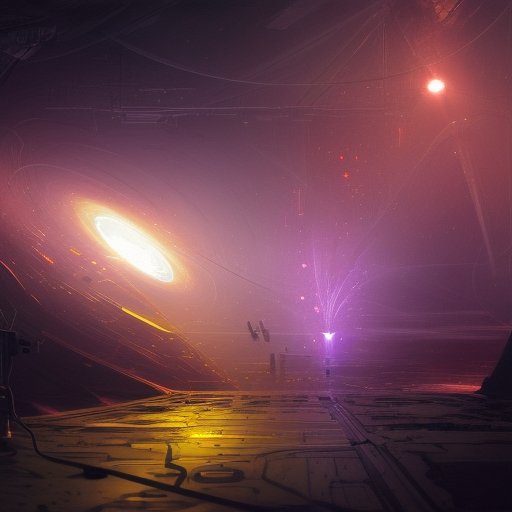
Prepare for a journey through the magic and madness of black hole navigation. This article delves into the science behind black holes, and outlines the challenges and dangers of entering and exiting these gravitational beasts. We’ll reveal secrets to navigating around the black hole using gravity to slingshot yourself out of danger. You will peek into the future of exploration, predicting the development of new technologies and techniques for conquering these fascinating cosmic phenomena. Discover the philosophical implications of our scrutiny over these infinite vacuums, and what impact it could have on humanity’s future. Buckle up, and embrace the awe-inspiring beauty and terror of black holes.
I. Introduction
Greetings, space adventurers! Today, we embark on a journey of discovery to explore the magic and mystery of one of the most fascinating cosmic phenomena: black holes. Why is exploring these infinitely deep, dark holes so important, you may ask? Well, first, black holes are among the most mysterious objects in the universe, and their study can help us unravel the secrets of the creation and evolution of the cosmos itself.

Black holes also pose profound scientific and philosophical implications. They can help us test Einstein’s theory of general relativity and provide clues for the nature of space-time and gravity. Through studying black holes, we can gain a deeper understanding of the inner workings of celestial objects, such as stars, planets, and galaxies, furthering our knowledge of their evolution and behavior.
Moreover, black holes are not just fascinating objects of scientific inquiry, but they also have the potential to benefit humanity in practical ways. Black holes could be a source of clean energy if we can learn to harness the immense power from their gravitational forces. Black hole exploration could also lead to the development of new technologies and innovations, including spacecraft navigation, communication systems, and faster-than-light travel.
But, let us not forget about the sheer thrill and wonder of exploring the unknown! Black holes represent the ultimate frontier, the epitome of human curiosity about the universe. What is inside a black hole? What happens beyond the event horizon? What kind of adventures await us on the other side?
So, put on your space suits, strap in, and get ready for an adventure of a lifetime! Join us as we traverse the treacherous terrain of black hole navigation, delving into the dizzying depths of the universe’s most enigmatic objects. Let the journey begin!
II. The science of black holes
Now, let’s take a closer look at the science behind black holes. A black hole is a region in space where the gravity is so strong that nothing, not even light, can escape its pull. They form when massive stars exhaust their fuel and collapse under the weight of their own gravity. This collapse creates a singularity at the center of the black hole, which is a point where all the matter is concentrated and space-time is infinitely curved.

Black holes come in different sizes, ranging from stellar-mass black holes, which are about three times the mass of the sun, to supermassive black holes, which can have a mass billions of times greater than the sun. Supermassive black holes are thought to be located at the centers of most galaxies, including our very own Milky Way.
One of the intriguing features of black holes is their event horizon, which is the point of no return beyond which anything that crosses is irreversibly sucked in by the black hole’s gravity. The event horizon is also where the gravitational pull becomes so great that time appears to stand still.
Another fascinating aspect of black holes is the connection they have with space-time, which is the fabric of the universe. Black holes warp space-time, causing time to slow down and space to warp in ways that can be observed through gravitational lensing.
Scientists use several methods to study black holes, including observations of their effect on nearby stars and gas, as well as detection of their gravitational waves. The study of black holes has been crucial to our understanding of the universe, revealing the existence of dark matter and dark energy and providing insights into the early universe.
III. Approaching a black hole
Approaching a black hole is not for the faint of heart, as there are many dangers and challenges to consider. First, the immense gravitational forces around a black hole are so strong that they can distort and even tear apart anything that comes too close, including spacecraft or even stars.

At the same time, the intense radiation and high temperatures near a black hole can fry any technology or equipment, making it difficult to capture data or communicate with the crew. Also, as a spacecraft approaches a black hole, it faces the risk of getting trapped in the gravitational pull and being pulled towards the event horizon of the black hole, from where there is no return.
To overcome these challenges, spacecraft must be equipped with specialized shields and heat-resistant materials, as well as advanced navigational technology that accounts for the intense gravitational fields. However, even with advanced technology, approaching a black hole remains a perilous and unpredictable endeavor.
Moreover, exploring a black hole requires meticulous planning and calculations, as the gravitational forces around the black hole can alter the trajectory of a spacecraft or even cause it to crash. Therefore, it is crucial for space agencies and explorers to consider every aspect of going near a black hole, from navigation to communication to the physical and mental health of the crew.
In addition, approaching a black hole not only poses technical challenges but also philosophical and ethical questions. Should we risk the lives of human astronauts for the sake of scientific inquiry? What are the consequences of exploring a black hole for the environment and the cosmos as a whole?
Despite these questions and challenges, the allure of black hole exploration persists, a testament to human curiosity and bravery. Join us for the next section as we explore the magic of navigating a black hole and the techniques that make escape possible.
IV. Navigating a black hole
Now, let us talk about the magic of navigating a black hole. As we discussed earlier, the gravitational force of a black hole is so immense that it can pull in anything that comes close to it, including light itself. So, how can a spacecraft navigate around a black hole without getting absorbed into its inky folds?

The answer lies in the power of gravity. Just like how planets orbit around a star, a spacecraft can slingshot around a black hole by using its gravitational force as a boost. By carefully calculating angles and trajectories, a spacecraft can use the black hole’s immense gravity like a slingshot, gaining tremendous speed and momentum.
This technique, also known as gravity assist, was first utilized by NASA’s Mariner 10 spacecraft in 1974 to explore Mercury, and has since been used in numerous space missions, including the famous Voyager and Cassini missions. Of course, navigating around a black hole is much more difficult than just swinging around a planet; a miscalculation could spell disaster.
But, what if we could control the gravity around a black hole? Recent studies suggest that we may be able to manipulate the space-time fabric around a black hole using lasers to carve out a path, creating a shortcut to travel faster than light. This technique, called “lensing” or “gravitational lensing,” could revolutionize space travel and open up a new era of interstellar exploration.
However, let us not forget the dangers of approaching a black hole. Even the slightest miscalculation can be disastrous, as the immense gravitational forces can rip apart a spacecraft in a matter of seconds. The radiation levels around a black hole can also be lethal, and the extreme temperatures and pressures can pose a significant challenge to spacecraft materials.
Navigating a black hole may be the ultimate test of human ingenuity, but the rewards are immense. By using the magic of gravity, we can unlock the secrets of black holes and explore the deepest, darkest corners of the universe. So, buckle up and get ready to experience the ride of a lifetime, as we traverse the battlefield of black hole navigation!
V. Exiting a black hole
Buckle up, space adventurers! Exiting a black hole is not as simple as entering it. Once you succumb to the gravitational pull, escape can seem impossible. Fear not, though, as we have some tips to help you safely navigate your way out of the black hole.

First, be patient. Exiting a black hole takes time, and you cannot rush the process. Wait until you’ve reached the farthest point of the object’s gravitational pull before attempting to break free.
Next, use your spacecraft’s engines to their fullest potential. To escape a black hole, you need to generate enough speed and energy to break free from its pull. Use all the power at your disposal and aim for a trajectory that avoids the black hole’s gravity well.
As you escape, beware of potential risks, such as high-energy radiation and tidal forces. You’ll also want to keep an eye on your trajectory and adjust your course as needed to avoid collision with other celestial objects.
Another important factor to consider is the fuel supply of your spacecraft. You’ll need to have enough fuel to sustain your engines until you’re entirely free of the black hole’s gravitational pull. Running out of fuel while still trapped in the black hole’s grasp can be disastrous, leaving you stranded forever.
Finally, remember that exiting a black hole is not for the faint-hearted. It takes skill, precision, and a bit of luck to escape safely. Prepare yourself mentally and physically for the task ahead, and remain focused on your goal.
VI. The future of black hole exploration
Now that we have seen the challenge and danger of black hole navigation, it’s time to look to the future. New technologies and techniques are already being developed to make black hole exploration a less daunting and more achievable task.

One of the most exciting developments is the use of unmanned spacecraft to undertake black hole missions. With recent advances in robotics and artificial intelligence, it’s now possible to send probes to orbit and make measurements of black holes from a safe distance. These probes can collect valuable data on black hole structure, behavior, and evolution, without risking human lives.
Another promising technology is gravitational wave detectors. These instruments can detect the minute ripples in space-time caused by the collision of black holes, providing a unique window into the workings of these cosmic beasts. By studying these waves, scientists can gain insight into the origins of black holes and their impact on the surrounding universe.
One of the most ambitious proposals is the creation of a “black hole starship,” a spacecraft equipped with the latest technology for surviving the hazards of black holes. These ships would use advanced materials and propulsion systems designed to withstand the intense gravitational forces of black holes, allowing for humans to make the journey and explore beyond the event horizon.
Moreover, future advancements in computing, data analysis, and artificial intelligence will be crucial in making sense of the vast amounts of information that black hole missions will produce. These tools will enable detailed modeling and simulations of black holes, allowing scientists to better understand their inner workings.
Finally, we can expect a growing interdisciplinary approach to black hole exploration, bringing together experts from fields such as physics, engineering, computer science, and philosophy. This collaboration will be essential in finding solutions to the complex problems of black hole navigation and answering the fundamental questions about the universe they pose.
So, while exploring black holes may still seem like science fiction, with continued advances in technology and the bravery of scientists and astronauts, we may one day unlock the secrets of these magnificent cosmic wonders.
VII. The philosophical implications of black hole exploration
Now, let’s delve deeper into the philosophical implications of black holes. What does our fascination and exploration of these cosmic wonderlands mean for humanity?

One aspect is the notion of our place in the universe. Black holes represent the unknown, the enigmatic, the unpredictable. As awestruck observers, we gaze into the abyss, searching for answers, for meaning, for purpose. The study of black holes puts us in our place, reminding us of our humble existence in a vast and ancient universe, where we are but mere specks of stardust.
Furthermore, the very act of exploring black holes brings us face-to-face with the fragility and the resilience of life itself. It highlights the immense challenges that we face as a species, from technological limitations to physical and psychological risks. Yet, it also reveals our remarkable adaptability, creativity, and persistence in the face of adversity.
In addition, black hole exploration raises ethical considerations around the consequences of our actions as a human race. What impact will our exploration have on the environment and the delicate balance of the universe? How can we ensure that our actions do not harm other life forms or irrevocably alter the cosmos?
Finally, black holes represent the ultimate mystery, the unknown frontier that we are driven to unravel. They challenge us to think beyond our current limitations, to push the boundaries of human knowledge, and to ask the big questions about the nature of existence itself.
VIII. Conclusion
And so, our journey through the wonder and terror of black holes comes to an end. We have explored the secrets of these cosmic giants, grappled with their immense power, and witnessed their beauty and horror. We have pondered the philosophical questions that loom over them and marveled at the technological advancements they could bring.

But perhaps, the most important lesson we have learned is the humility that comes with contemplating the vastness of the universe. Black holes remind us of our smallness, our transience, and our fragility. They humble us with their infinite depths and remind us of the mysteries that yet lie beyond our reach.
Yet, they also inspire us with their beauty, their complexity, and their sheer scale. They challenge us to reach beyond our limits, to push the boundaries of our knowledge, and to explore the greatest unknowns of the universe.
As we conclude our journey, we cannot help but feel a sense of awe and wonder at the majesty of black holes. We have witnessed the duality of their nature- their terrifying and destructive power, and their beauty and elegance.
So, let us continue to explore the cosmos, to unravel the enigmas that it holds, and to revel in the magic and wonder of the universe. For who knows what other treasures and terrors lie hidden beyond the event horizon of a black hole?






